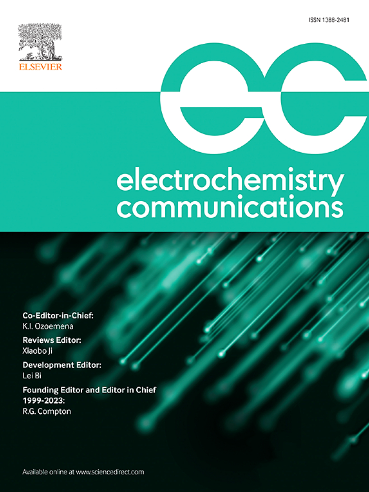Elucidating the electrochemical behavior and reaction pathway of 1,4-Dioxane: An integrated experimental and simulation approach
IF 4.2
3区 工程技术
Q2 ELECTROCHEMISTRY
引用次数: 0
Abstract
1,4-Dioxane, a potential human carcinogen, poses significant environmental challenges as a contaminant in water resources, and the efficient degradation of this compound is crucial for successfully optimizing its electrochemical removal. For the prediction and enhancement of degradation efficiency, a precise identification of kinetic parameters, reaction conditions, and degradation products, along with an understanding of the mechanisms involved, is required. But, most of these parameters are often not provided in the current literature. This study investigates the electrochemical behavior and reaction mechanism of 1,4-Dioxane using palladium‑ruthenium bimetallic nanocatalysts on glassy carbon electrodes by both experimental and simulation analyses. The characterization of fabricated nanocatalyst was carried out using STEM-EDX and UV–visible spectroscopy. The electrochemical features and redox reaction mechanism of 1,4-dioxane were systematically explained through the quantification of the half-wave potential (E1/2), diffusion coefficient (D), rate constant (k), transfer coefficient (α), and charge transfer resistance (Rct), utilizing cyclic voltammetry (CV), chronoamperometry (CA), rotating disk electrode - hydrodynamic voltammetry (RDE-HDV), and electrochemical impedance spectroscopy (EIS). Simulations conducted with the KISSA1D software yielded convincing findings that align with the experimental results, confirming the accuracy of the modeling and underlining the reliability of the experimental methodology. In addition, the final reduction of 1,4-dioxane to carbon dioxide and water was revealed by LC-MS analysis. This research improves our understanding of the kinetic behaviors and underlying mechanisms in redox reactions and fills the gap between theoretical concepts and practical applications in electrochemistry, and environmental chemistry.
1,4-二氧六环的电化学行为和反应途径研究:实验与模拟相结合的方法
1,4-二氧六环是一种潜在的人类致癌物,作为水资源中的污染物对环境构成了重大挑战,有效降解该化合物是成功优化其电化学去除的关键。为了预测和提高降解效率,需要精确识别动力学参数、反应条件和降解产物,以及对所涉及的机制的理解。但是,目前的文献中往往没有提供这些参数。通过实验和模拟分析,研究了钯钌双金属纳米催化剂对1,4-二氧六环在玻碳电极上的电化学行为和反应机理。利用STEM-EDX和紫外可见光谱对制备的纳米催化剂进行了表征。采用循环伏安法(CV)、计时伏安法(CA)、旋转盘电极-流体动力伏安法(RDE-HDV)和电化学阻抗法(EIS),通过对半波电位(E1/2)、扩散系数(D)、速率常数(k)、传递系数(α)和电荷转移电阻(Rct)的定量分析,系统地解释了1,4-二恶烷的电化学特性和氧化还原反应机理。使用KISSA1D软件进行的模拟产生了与实验结果一致的令人信服的结果,证实了建模的准确性,并强调了实验方法的可靠性。此外,LC-MS分析还揭示了1,4-二恶烷最终还原为二氧化碳和水的过程。该研究提高了我们对氧化还原反应的动力学行为和潜在机制的理解,填补了电化学和环境化学中理论概念与实际应用之间的空白。
本文章由计算机程序翻译,如有差异,请以英文原文为准。
求助全文
约1分钟内获得全文
求助全文
来源期刊

Electrochemistry Communications
工程技术-电化学
CiteScore
8.50
自引率
3.70%
发文量
160
审稿时长
1.2 months
期刊介绍:
Electrochemistry Communications is an open access journal providing fast dissemination of short communications, full communications and mini reviews covering the whole field of electrochemistry which merit urgent publication. Short communications are limited to a maximum of 20,000 characters (including spaces) while full communications and mini reviews are limited to 25,000 characters (including spaces). Supplementary information is permitted for full communications and mini reviews but not for short communications. We aim to be the fastest journal in electrochemistry for these types of papers.
 求助内容:
求助内容: 应助结果提醒方式:
应助结果提醒方式:


